In the documentation below, advanced topics are
described in this smaller font size.
CPC View is distributed in two distinct variants:
For the purposes of this document, we will refer to CPC View when
describing functionality common to all variants of the viewer, and the
variant-specific name (e.g., CPC View ax) when describing functionality
specific to a particular variant.
| Format | Mime type | Typical extensions | As of version |
|---|---|---|---|
| CPC | image/cpi | .cpi, .cpc | 1.0 |
| TIFF | image/tiff | .tiff, .tif | b/w 1.0; color/gray 4.3.0 |
| Portable Bitmap | image/pbm | .pbm, .pgm, .ppm, .pnm | 1.0 |
| JEDMICS C4 | image/c4 | .c4, .ct4 | 4.3.0 |
| CALS | image/cals | .cals, .cal | 4.3.0 |
| JFAX documents | application/tiff | .jfx, .jfax | 4.3.0 |
regsvr32 "<path-to-ocx-file>"where <path-to-ocx-file> is replaced with the full pathname of the OCX file that you downloaded. For example, if you saved the CPC View ax control to
regsvr32 "c:\Program Files\Cartesian Products\CpcViewAX.ocx"
![]() Once the control has been manually installed, the CpcViewAX.ocx file should not be
moved. If you do move the file, you must re-install the control.
Once the control has been manually installed, the CpcViewAX.ocx file should not be
moved. If you do move the file, you must re-install the control.
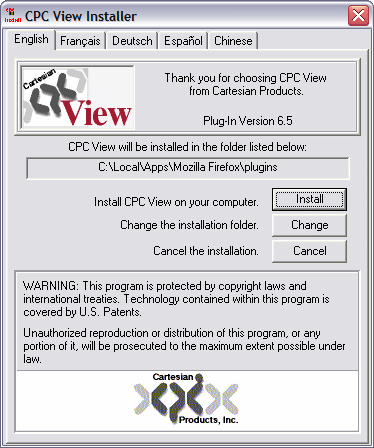 To install CPC View pi, you will need the CPC View pi installation program.
If you do not have the installation program, you can
download it from our web site.
To install CPC View pi, you will need the CPC View pi installation program.
If you do not have the installation program, you can
download it from our web site.
Once you have retrieved the installation program, follow these simple instructions:
By default, the Firefox browser is located at:
C:\Program Files\Mozilla Firefox\Firefox.exe
For example, if you have CPC View installed, you can display an image in CPC View
by clicking here.
regsvr32 /u "c:\Program Files\Cartesian Products\CpcViewAX.ocx"
Once the control has been uninstalled, you can delete the CpcViewAX.ocx
file.
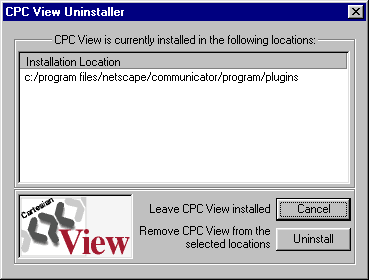 CPC View pi (v5.1 or later) can be uninstalled via the Add/Remove Programs
facility of the Windows Control Panel. The following procedure can be used to
uninstall CPC View pi:
CPC View pi (v5.1 or later) can be uninstalled via the Add/Remove Programs
facility of the Windows Control Panel. The following procedure can be used to
uninstall CPC View pi:
The "plugins" folder is located in the same folder as your
web browser executable. If you are unsure of the location
of this folder, you can use the "Find/Files or Folders..." command
in the Windows "Start" menu to locate the file NPCPC32.dll.
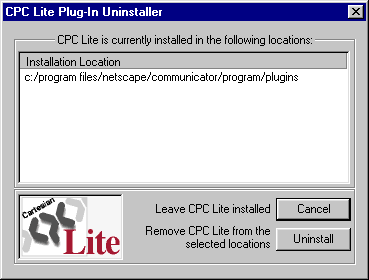 CPC Lite pi (v5.1 or later) can be uninstalled via the Add/Remove Programs
facility of the Windows Control Panel. The following procedure can be used to
uninstall CPC Lite pi:
CPC Lite pi (v5.1 or later) can be uninstalled via the Add/Remove Programs
facility of the Windows Control Panel. The following procedure can be used to
uninstall CPC Lite pi:
The "plugins" folder is located in the same folder as your
web browser executable. If you are unsure of the location
of this folder, you can use the "Find/Files or Folders..." command
in the Windows "Start" menu to locate the file NPCPC32.dll.
 Once the viewer is running, the CPC toolbar provides status information about the currently displayed
document, as well as providing access to the most commonly used functions
of the viewer. The following sections describe the functionality of the toolbar.
Once the viewer is running, the CPC toolbar provides status information about the currently displayed
document, as well as providing access to the most commonly used functions
of the viewer. The following sections describe the functionality of the toolbar.
![]() By default, the document is
brought up in page view. You can move to the thumbnail view by
selecting the right "thumbnail" button in the "View" control or
double-clicking on the image. You can return to page view from
thumbnail view by selecting the left "page" button in the "View" control
or double-clicking on the thumbnail representing the page to move to.
By default, the document is
brought up in page view. You can move to the thumbnail view by
selecting the right "thumbnail" button in the "View" control or
double-clicking on the image. You can return to page view from
thumbnail view by selecting the left "page" button in the "View" control
or double-clicking on the thumbnail representing the page to move to.
While in thumbnail view, you can use the mouse to select multiple pages within the document. This can be helpful when printing or saving a subset of the pages within the document. When you invoke the Print or Save commands from thumbnail view with multiple pages selected, the command dialog box defaults to a page range containing only the selected pages.
You can control which pages are selected as follows:
The view selection functionality is also available through
a menu on the right mouse button within the viewer.
The View sub-menu contains a "Properties..." command that displays
any properties of the document, such as resolution, image size, and
document source that may be stored with the image.
Use the back  and
forward
and
forward  buttons to navigate
among the history of pages within the document that you have viewed.
Similar to the back and forward buttons on a web browser, the
back
buttons to navigate
among the history of pages within the document that you have viewed.
Similar to the back and forward buttons on a web browser, the
back  button takes you back to the
previously viewed page and the forward
button takes you back to the
previously viewed page and the forward  button moves you forward to the next viewed page.
button moves you forward to the next viewed page.
You can also navigate through the pages of the document using the left and right arrow keys on the keyboard.
The page selection functionality is also available through a menu on the right mouse button within the viewer.
If the document contains only a single page, the page navigation functions are disabled.
![]() The "Mouse" control,
pictured at left, determines the current mouse mode that the viewer is in.
By default, the viewer is in "scroll" mode, as indicated by the hand
button being depressed. (The magnifying glass button puts the
viewer in "zoom" mode;
the pencil button puts the viewer in "annotation" mode.)
When in scroll mode, the
mouse can be used to "grab" a point on the image and drag it around on
the screen.
The "Mouse" control,
pictured at left, determines the current mouse mode that the viewer is in.
By default, the viewer is in "scroll" mode, as indicated by the hand
button being depressed. (The magnifying glass button puts the
viewer in "zoom" mode;
the pencil button puts the viewer in "annotation" mode.)
When in scroll mode, the
mouse can be used to "grab" a point on the image and drag it around on
the screen.
![]() In addition, the "Scrollpad"
control, which looks like a yellow rectangle on a white page
background, can be used for scrolling. The yellow rectangle depicts
the position of the viewer window on the page image. By dragging the
yellow rectangle around, the viewer window can be moved over the page.
In addition, the "Scrollpad"
control, which looks like a yellow rectangle on a white page
background, can be used for scrolling. The yellow rectangle depicts
the position of the viewer window on the page image. By dragging the
yellow rectangle around, the viewer window can be moved over the page.
The scaling functionality is also available through a menu on the right mouse button within the viewer.
The horizontal double arrow and vertical double arrow buttons force
a scale factor that fits the current page to fit within the width or
height, respectively, of the viewer window.
If the horizontal double arrow button is selected, the arrows and
current scale pop-up govern the number of images per row. If the
vertical double arrow button is selected, the arrows and current scale
govern the number of images per column.
The zoom operation may be cancelled by clicking on the right mouse button prior to releasing the left mouse button, which switches back to "scroll" mode. There is also an "Undo last zoom" operation available from the right mouse menu, which allows undoing the sequence of zoom operations that have been executed since the document was opened.
Scaling factors for the fit-to-width options and so forth are generally chosen to maximize image quality, rather than exactly fill the screen. Selecting "Enable Precision Zoom" option from the Zoom sub-menu of the right mouse menu causes the viewer to allow scalings that exactly fill the screen, at some cost in image quality and rendering speed. This option is generally not recommended but is incorporated for special applications.
This option is only available when displaying black-and-white documents; precision
zooming is not supported on grayscale and color documents.
By default, the "Color" control is not provided in the toolbar.
You can add it to the toolbar using the toolbar configuration methods
described below.
To change the default location of the toolbar, click on one of the bottom buttons in the "Configure Controls" dialog box. By default, the toolbar is at the top, but you can select left, right, or bottom as well.
You can get rid of the toolbar completely by selecting the option "none" from the "Toolbar" submenu of the right mouse menu.
![]() To change
the order in which the various controls appear in the toolbar, you can
drag the controls around with the left mouse button by mousing down on
a point in the control that is not otherwise mouse-sensitive. (The
mini-title-bar of the control is a natural place to use.)
Alternatively, you can hold down the "Alt" key and mouse down anywhere
in the control to drag the control. (Prior to Version 4.2 of CPC
View, dragging controls required use of the "Alt" key.) The controls
snap into place as you drag them past other controls. The figure at
right shows the screen as the user is moving the "Rotation" control to
the right.
To change
the order in which the various controls appear in the toolbar, you can
drag the controls around with the left mouse button by mousing down on
a point in the control that is not otherwise mouse-sensitive. (The
mini-title-bar of the control is a natural place to use.)
Alternatively, you can hold down the "Alt" key and mouse down anywhere
in the control to drag the control. (Prior to Version 4.2 of CPC
View, dragging controls required use of the "Alt" key.) The controls
snap into place as you drag them past other controls. The figure at
right shows the screen as the user is moving the "Rotation" control to
the right.
All configuration changes are preserved so that the next time you
run the viewer, the toolbar will be set up just the way you like it.
The different sections of the menu provide the same functionality as the "Page" control, the "Zoom" control, the "View" control, the "Rotation" control, the "Color" control, the Toolbar Position control, and the Mouse control. The Document sub-menu contains commands to save the current document to a file (optionally converting it to a different file format), to email the current document, and to print the current document.
The right mouse menu also provides access to functionality that is not available
via the CPC toolbar.
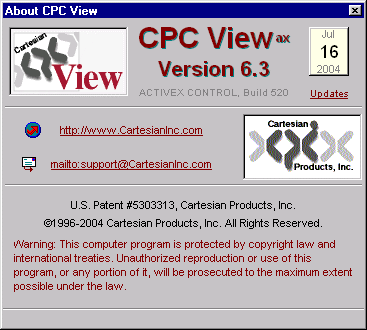 Find out about your version of CPC View, including the license
that you are working under, with the "About CPC View..."
or "About CPC Lite..." menu item.
Find out about your version of CPC View, including the license
that you are working under, with the "About CPC View..."
or "About CPC Lite..." menu item.
The About CPC window is displayed to the right. Several of the items in the window are hyper-linked:
You can also check for updates by visiting the CPC View Update page at the Cartesian web site.
The annotations themselves - Annotations will be shown overlayed on the images regardless of magnification and in both page and thumbnail views.
 Annotation count -
The title bar of the document (see
sample at right) will show a count of the number of annotations on the
current page, e.g., 2 Annotations.
Annotation count -
The title bar of the document (see
sample at right) will show a count of the number of annotations on the
current page, e.g., 2 Annotations.
Annotation check box - A check box next to the annotation count allows you to hide all the annotations.
Underlying image - If the document consists of annotations
overlayed on a separate image file, the URL of the underlying image
file is given next to a paper clip icon ( ). Clicking on the paper clip causes the
browser to a open a new window viewing this underlying image file.
). Clicking on the paper clip causes the
browser to a open a new window viewing this underlying image file.
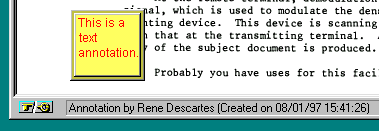 Status line - Placing the mouse cursor over an
annotation highlights the annotation and may cause the status line at
the bottom of the browser to display a "tip message" (as depicted at
right).
Status line - Placing the mouse cursor over an
annotation highlights the annotation and may cause the status line at
the bottom of the browser to display a "tip message" (as depicted at
right).
| Capability | Icon |
|---|---|
| Text pop-up | |
| Sound attachment | |
| Hyperlink |
![]() The figure at left shows an annotation with associated text
pop-up, sound attachment, and hyperlink. To view the attachments
or access the hyperlink, you would simply click on the annotation.
The figure at left shows an annotation with associated text
pop-up, sound attachment, and hyperlink. To view the attachments
or access the hyperlink, you would simply click on the annotation.
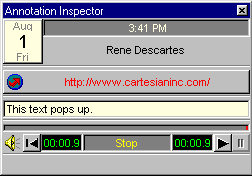 Clicking on an annotation
will pop up an "annotation inspector", which displays information about
the annotation. A sample annotation inspector
for the annotation above is shown at right.
Clicking on an annotation
will pop up an "annotation inspector", which displays information about
the annotation. A sample annotation inspector
for the annotation above is shown at right.
If the annotation has a hyperlink, and it does not have sound or pop-up text, clicking on the annotation will follow the hyperlink. To display the annotation inspector for such an annotation, click the annotation with the right mouse button.
The annotation inspector, like all of the inspector dialog boxes in CPC View, has a simple internal help facility. The line at the bottom of the annotation inspector provides a "tip" describing the content or function of whatever part of the inspector the mouse is over.
The annotation inspector displays the date and time that the annotation was created and the name of the person who added the annotation. (To change the name associated with your annotations use the View/Preferences... command in the right mouse menu.)
 You must enter
Annotation Mode to compose new annotations. (You can view annotations
in any mode.) To enter Annotation Mode, click on the pencil button in
the "Mouse"
control section of the toolbar. (Or, use the "Mouse/Annotate"
option on the right mouse menu.)
You must enter
Annotation Mode to compose new annotations. (You can view annotations
in any mode.) To enter Annotation Mode, click on the pencil button in
the "Mouse"
control section of the toolbar. (Or, use the "Mouse/Annotate"
option on the right mouse menu.)
To select an annotation, click the left mouse button on it. A red border with blue control points will appear around the annotations bounding box.
To resize a selected annotation, drag the blue control points.
To move a selected annotation, drag starting within the bounding box itself.
To edit a text annotation,double-click on the annotation.

The controls in the annotation toolbar can be reconfigured,
just like the controls in the main
toolbar.
 The left-most group of
controls, labeled "Palette", contains a variety of drawing tools. To
add an annotation, select one of the tools in the palette by clicking
on it with the left button. You can then add annotations to the image
by dragging the mouse over the document.
The left-most group of
controls, labeled "Palette", contains a variety of drawing tools. To
add an annotation, select one of the tools in the palette by clicking
on it with the left button. You can then add annotations to the image
by dragging the mouse over the document.
 To the right of the
"Edit" group is the clipboard. Annotations can be moved to the
clipboard by cutting or copying them. Whenever an annotation is on
the Windows clipboard, a small small rendering of it is displayed over
the Clipboard icon. To paste the annotation, click on the clipboard or
use the "Insert" menu item on the right mouse menu.
To the right of the
"Edit" group is the clipboard. Annotations can be moved to the
clipboard by cutting or copying them. Whenever an annotation is on
the Windows clipboard, a small small rendering of it is displayed over
the Clipboard icon. To paste the annotation, click on the clipboard or
use the "Insert" menu item on the right mouse menu.
Clicking on the small book icon to the right of the clipboard pops
up a list of annotations that have recently been placed on the
clipboard. You can click on them to insert
them onto the current page.
 The center group of controls,
labeled "Edit", contains buttons to cut, delete, and copy
annotations. Additionally, the CPC View annotation editor maintains a
complete undo/redo list of all changes to the document during the
current session. The counter-clockwise arrow will undo the most recent
change; the clockwise arrow will redo the most recent change that was
undone. Clicking repeatedly on the undo button will undo more and
more of the changes.
The center group of controls,
labeled "Edit", contains buttons to cut, delete, and copy
annotations. Additionally, the CPC View annotation editor maintains a
complete undo/redo list of all changes to the document during the
current session. The counter-clockwise arrow will undo the most recent
change; the clockwise arrow will redo the most recent change that was
undone. Clicking repeatedly on the undo button will undo more and
more of the changes.
To delete all of the annotations on the current page, click the right
mouse button anywhere on the background image and select Delete All
from the menu that appears.
 In general, CPC View will
automatically save your annotations to files in the Annotation
Folder you selected. The files are saved such that the next time
you view the same URL, the annotations will be automatically
loaded. While CPC View is in its automatic save mode, the text in the
"Save" group will display "<automatic>".
In general, CPC View will
automatically save your annotations to files in the Annotation
Folder you selected. The files are saved such that the next time
you view the same URL, the annotations will be automatically
loaded. While CPC View is in its automatic save mode, the text in the
"Save" group will display "<automatic>".
You can also save annotations explicitly. Click on the button to
the right of the text (or the text itself) to select a file in which
to save the annotations. Explicitly saved annotations are
When you view annotations in a saved annotation file, the text
in the "Save" group will display the name of the file.
If you modify the annotations,
the left "Save" button will be enabled. This button allows you to
save the annotations back to the file.
If the annotations for the document come from a remote
Annotation Server,
the text in the "Save" group will display "<remote>". If you modify
the annotations, the left "Save" button will be enabled. This button allows you to
save the annotations back to the remote server.
If your machine has MAPI installed (for instance, if you run
Microsoft Exchange), there will be an email button in the save
group. Use this button to email annotated documents.
Added palette items are persistent; they stay available from one
session to the next.
Each type has associated with it a variety of general and specific
properties. To change the properties associated with an annotation,
click on the annotation with the right mouse button to display a menu
of commands. The "Properties..." command pops up an inspector dialog box
that allows you to edit the various properties of the annotation.
For non-text annotations, you can also access the inspector by double-clicking
on the annotation.
You can also use the right mouse menu on the
palette buttons to change the properties of the palette tools
themselves.
In addition, all allow control of the actions associated with the
annotation, that is, text pop-up, sound attachments, hyperlinks, and
status line messages. These are controlled with a set of four tab
items at the bottom of the inspector dialog.
Clicking on the small book icon to the right of the text area pops
up a list of previously used pop-up text items. You can click on them
to insert them.
A convenient way to generate this URL when the destination
is a document viewable by CPC View (perhaps a different page of the
current document) is to use the "Document/Copy URL" option from the
right mouse menu. This copies the current URL so that it can be
pasted into the URL area; a "Paste" option will be in the right mouse
menu when the cursor is in the URL area.
Clicking on the small book icon to the right of the URL area pops
up a list of previously used destination URLs. You can click on them
to insert them.
Clicking on the small book icon to the right of the text area pops
up a list of previously used tip messages. You can click on them
to insert them.
If the printer button is not present on the CPC toolbar, you can
add it to the toolbar using the toolbar configuration methods
described below.
The end page of a contiguous range can be left empty. This is interpreted as a range that ends with the
last page of the document. For example, the range 3- specifies all pages from
the 3rd page on.
If the current document contains only one page, this option is disabled.
If only a single page is specified in the print range,
this option is disabled.
If the save button is not present on the CPC toolbar, you can
add it to the toolbar using the toolbar configuration methods
described below.
The file formats available for a particular document depend on the color format
of the document (black-and-white; gray-scale; color), as well as whether or not
the document contains annotations.
If the document has annotations, the following additional file formats are available:
During the burn-in, the annotations are rendered in black-and-white,
similar to their appearence when printed to a black-and-white printer.
If the document has annotations, the following additional file formats are available:
If the document has annotations, the following additional file formats are available:
This type is equivalent to using your web browser's File/Save As... command (assuming
your web browser supports this command for embedded documents).
To specify a range of pages, select the "Range" option and enter the page ranges
into the adjacent text box.
Each page range is specified as either a single page (e.g., 5) or a
contiguous range of pages (e.g., 3-7). Multiple ranges should be separated
by commas or spaces (e.g., 1, 2, 4-6).
The end page of a contiguous range can be left empty. This is interpreted as a range that ends with the
last page of the document. For example, the range 3- specifies all pages from
the 3rd page on.
This set of controls is NOT available when the Save as type is set to either
CPC Annotations (annotations only) or CPC Annotated Document. With these
types, CPC View always includes all of the source pages in the saved document.
A battery is NOT required for conversion of CPC source documents; the viewer will freely convert
CPC images to the TIFF, PDF, or PBM file formats.
Invoking the email command will bring up the dialog box depicted to the right.
This dialog allows selection of the file format to use for the document attachment.
Once you have choosen the
attachment format, click the OK button. This will cause a new
message with the document attachment to be created in your email program.
If the document contains a table of contents, CPC View will display the Contents Bar
at the top of the document window.
The Contents Bar provides information about the currently displayed section of the document,
as well as tools with which to navigate among the document's sections.
If the CPC toolbar is at the top of the document window, the Contents Bar
will be displayed at the bottom of the document window.
Clicking on an entry title will also close the contents window. To close the
contents window without selecting an entry, click on the small x in the upper
right corner of the window.
The command is available in both page view and thumbnail view.
In thumbnail view, it copies the currently visible thumbnails to the clipboard.
The copy function can also be activated by typing 'c' while the image window has
keyboard focus.
If you answer "NO" to the registration question, the start-up check is disabled.
The document title is specified in the document's meta-data. If the document does not
have a title, the initial output filename is always set to the filename of the document,
regardless of the setting of this option.
Annotations are automatically stored in this folder when you annotate a document
and then close it (for example, by moving to a different web page) without first explicitly
saving the annotations to a file.
On return to the document, CPC View will automatically load the previously saved
annotations.
The target URL for the Help... command (available from the
CPC right mouse menu) can be specified in the registry.
To specify the
target URL, create a string value named Help within the following registry key:
For example, setting the Help value to "http://foobar.com" would
cause CPC View to open "http://foobar.com" whenever the Help...
command is invoked.
The following example regedit file specifies that the help
page is at "http://localmirror.com/Help/help.cgi?which=cpcview".
If you would like to change the Help target for the current user, rather than
all users, edit the registry key
HKEY_CURRENT_USER\Software\Cartesian Products\CPC View\URLs rather
than HKEY_LOCAL_MACHINE\SOFTWARE\Cartesian Products\CPC View\URLs.
![]() The image document
itself is converted to CPC format and included in the email attachment.
If the source image document is not already in CPC format,
this operation requires a conversion battery.
The image document
itself is converted to CPC format and included in the email attachment.
If the source image document is not already in CPC format,
this operation requires a conversion battery.
Adding new palette items
You can make any annotation into a new palette item by clicking the
right mouse button on the annotation and selecting the "Edit/Add to
Palette" option on the right mouse menu. This will place a miniature
copy of the annotation in the palette, which acts as a new palette
tool for adding copies of this annotation. For instance, you might
add a new tool for placing the text "Approved" in large red letters.
4.2.4. Annotation Properties
There are five basic types of annotations:
General annotation properties
 All of the inspectors allow control
of properties of the "paper" on which the annotation is drawn, that
is, the background of the bounding box of the annotation. The color
and transparency of the paper can be controlled, as well as the type of
border (shadow, inset, embossed, none).
All of the inspectors allow control
of properties of the "paper" on which the annotation is drawn, that
is, the background of the bounding box of the annotation. The color
and transparency of the paper can be controlled, as well as the type of
border (shadow, inset, embossed, none).
 The text action tab
item allows you to edit the text that will be popped up in the
annotation inspector when the annotation is
clicked on.
The text action tab
item allows you to edit the text that will be popped up in the
annotation inspector when the annotation is
clicked on.
 The hyperlink
action tab item allows you to add the URL of the hyperlink
destination for this annotation.
The hyperlink
action tab item allows you to add the URL of the hyperlink
destination for this annotation.
 The sound action
tab item contains controls as for a tape recorder, for recording and
playback of the sound attachment.
The sound action
tab item contains controls as for a tape recorder, for recording and
playback of the sound attachment.
 The tip action tab
item allows you to add text to be displayed as a tip on the browser's
status line when the mouse is over this annotation. (By default, the
tip used contains the date, time, and author of the annotation, as
shown above.
The tip action tab
item allows you to add text to be displayed as a tip on the browser's
status line when the mouse is over this annotation. (By default, the
tip used contains the date, time, and author of the annotation, as
shown above.
Text annotation properties
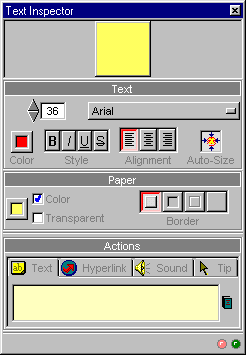 The "Properties" menu
item for a text annotation pops up the "text inspector" (depicted at
right), which allows you to control the font, size, color, and style
of the text. In addition,
The "Properties" menu
item for a text annotation pops up the "text inspector" (depicted at
right), which allows you to control the font, size, color, and style
of the text. In addition,
Box annotation properties
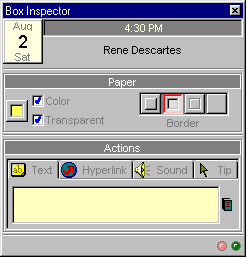 The "Properties" menu
item for a box annotation pops up the "box inspector" (depicted at
right). The actions and paper properties can be
controlled as described above.
The "Properties" menu
item for a box annotation pops up the "box inspector" (depicted at
right). The actions and paper properties can be
controlled as described above.
Circle annotation properties
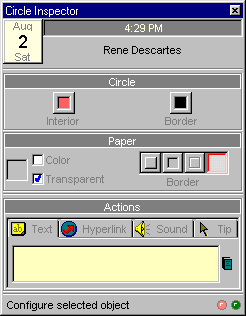 The "Properties"
menu item for a circle annotation pops up the "circle inspector"
(depicted at right), which allows you to control the colors of the
circle interior and border. In addition, the actions and paper
properties can be controlled as described above.
The "Properties"
menu item for a circle annotation pops up the "circle inspector"
(depicted at right), which allows you to control the colors of the
circle interior and border. In addition, the actions and paper
properties can be controlled as described above.
Line annotation properties
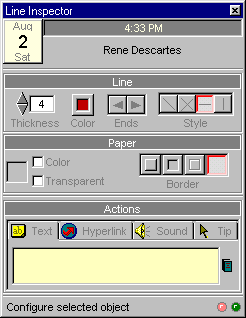 The "Properties" menu
item for a line annotation pops up the "line inspector" (depicted at
right), which allows you to control the line thickness and color, the
addition of arrowheads at either end of the line, and the relation of
the line to the annotations bounding box (single diagonal, both
diagonals, horizontal, or vertical). In addition, the actions and
paper properties can be controlled as described above.
The "Properties" menu
item for a line annotation pops up the "line inspector" (depicted at
right), which allows you to control the line thickness and color, the
addition of arrowheads at either end of the line, and the relation of
the line to the annotations bounding box (single diagonal, both
diagonals, horizontal, or vertical). In addition, the actions and
paper properties can be controlled as described above.
Freehand annotation properties
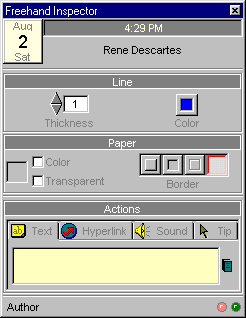 The "Properties"
menu item for a freehand line annotation pops up the "freehand
inspector" (depicted at right), which allows you to control the line
thickness and color. In addition, the actions and paper properties
can be controlled as described above.
The "Properties"
menu item for a freehand line annotation pops up the "freehand
inspector" (depicted at right), which allows you to control the line
thickness and color. In addition, the actions and paper properties
can be controlled as described above.
5. Printing Documents
 To print a document, click the printer button on the
CPC toolbar. Or, choose Print... from the
Document sub-menu of the right mouse menu.
To print a document, click the printer button on the
CPC toolbar. Or, choose Print... from the
Document sub-menu of the right mouse menu.
![]() Because of limitations in Microsoft Internet Explorer, CPC View
cannot support printing invoked via Internet Explorer's toolbar or "File"
menu. Under Internet Explorer, you must use the CPC toolbar button or right mouse
menu to invoke printing.
Because of limitations in Microsoft Internet Explorer, CPC View
cannot support printing invoked via Internet Explorer's toolbar or "File"
menu. Under Internet Explorer, you must use the CPC toolbar button or right mouse
menu to invoke printing.
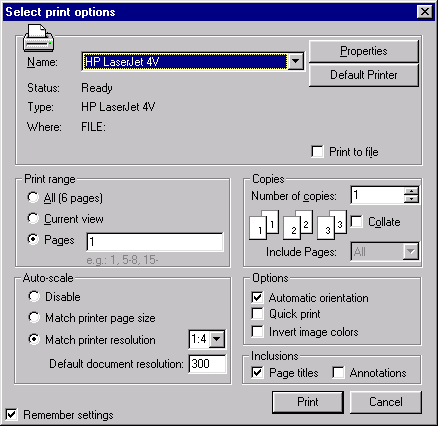 Invoking the print command will bring up the dialog box
depicted to the right. (Click on the figure for a full-size version.)
Use the dialog box to select the printer and other options.
Standard Windows controls allow selection of: the printer, the range of
pages to print, the number of copies to print and collation
preferences. Several additional CPC-specific options
are described in more detail below.
Once the appropriate options are selected, click the Print button to
initiate printing.
Invoking the print command will bring up the dialog box
depicted to the right. (Click on the figure for a full-size version.)
Use the dialog box to select the printer and other options.
Standard Windows controls allow selection of: the printer, the range of
pages to print, the number of copies to print and collation
preferences. Several additional CPC-specific options
are described in more detail below.
Once the appropriate options are selected, click the Print button to
initiate printing.
5.1. Print range
 The Print range options select the range of pages
to print:
The Print range options select the range of pages
to print:
If the entire page is currently visible in the image window, this option
is disabled.
5.2. Copies
 The Copies options determine the number of copies to print, collation of
copies, and odd/even printing:
The Copies options determine the number of copies to print, collation of
copies, and odd/even printing:
5.3. Auto-scale
![]() The Auto-scale options determine the scaling of
the pages when printed to the printer.
The Auto-scale options determine the scaling of
the pages when printed to the printer.
![]() The current zoom
magnification on the screen does not affect the print scaling,
except when using the current view option described above.
The current zoom
magnification on the screen does not affect the print scaling,
except when using the current view option described above.
5.4. Options
![]() This group of controls enables various printing features.
This group of controls enables various printing features.
5.5. Inclusions
![]() This group of controls enables various additional items that are printed on the page
along with the image.
This group of controls enables various additional items that are printed on the page
along with the image.
5.6. Remember Settings
 If the "Remember settings" option is checked, the viewer will make the current settings
the default settings for subsequent invocations of the print command. The default settings include the
selected printer and printer properties, as well as the "Print range",
"Auto-scale", "Options", and "Inclusions" settings.
If the "Remember settings" option is checked, the viewer will make the current settings
the default settings for subsequent invocations of the print command. The default settings include the
selected printer and printer properties, as well as the "Print range",
"Auto-scale", "Options", and "Inclusions" settings.
5.7. Default Printer
 The "Default Printer" button resets the printer to the system default printer and sets the printer properties to
the system default properties.
The "Default Printer" button resets the printer to the system default printer and sets the printer properties to
the system default properties.
6. Saving Documents
 To save a document displayed by CPC View, click the save button on the
CPC toolbar. Or, choose Save As... from the
Document sub-menu of the right mouse menu.
To save a document displayed by CPC View, click the save button on the
CPC toolbar. Or, choose Save As... from the
Document sub-menu of the right mouse menu.
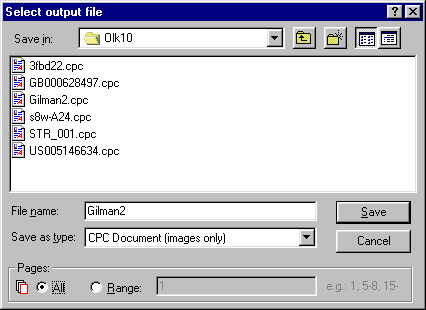 Invoking the save command will bring up the dialog box
depicted to the right. (Click on the figure for a full-size version.)
Standard Windows controls allow selection of the file name, folder, and file format.
CPC-specific controls
are described in more detail below.
Once the appropriate options are selected, click the Save button to
initiate the save.
Invoking the save command will bring up the dialog box
depicted to the right. (Click on the figure for a full-size version.)
Standard Windows controls allow selection of the file name, folder, and file format.
CPC-specific controls
are described in more detail below.
Once the appropriate options are selected, click the Save button to
initiate the save.
6.1. Save As Type
 CPC View can save the document in a variety of different file formats. The
Save as type drop-down menu is used to specify the particular
file format desired.
CPC View can save the document in a variety of different file formats. The
Save as type drop-down menu is used to specify the particular
file format desired.
6.1.1. Black-and-White Formats
Black-and-white images can be saved in any of the following file formats:
6.1.2. Gray-Scale Images
Gray-scale images can be saved in any of the following file formats:
6.1.3. Color Images
Color images can be saved in any of the following file formats:
6.1.4. Original
All non-CPC source documents provide an
Original "Save as type"; this type causes CPC View to save an exact copy of the original
source file.
6.2. Page Range
 This group of controls is used to specify the pages of the source document to include
in the saved file. To specify all of the pages in the source document, select the "All" option.
This group of controls is used to specify the pages of the source document to include
in the saved file. To specify all of the pages in the source document, select the "All" option.
6.3. Conversion Batteries
If the source document is not in the CPC file format, the conversion of the source
document to other file formats, such as CPC, requires the installation of a
CPC conversion battery. The installation
of the viewer
includes a 1000 page conversion battery.
7. Emailing Documents
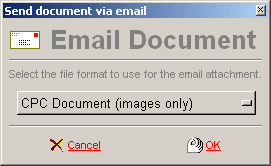 To email the document displayed by CPC View, select the
Email Document... command from the Document sub-menu of
the right mouse menu.
To email the document displayed by CPC View, select the
Email Document... command from the Document sub-menu of
the right mouse menu.
![]() The ability to specify the file format of the attachment requires CPC View v6.4 or later.
In earlier versions, the attachment is always created in the CPC file format.
The ability to specify the file format of the attachment requires CPC View v6.4 or later.
In earlier versions, the attachment is always created in the CPC file format.
8. The Contents Bar

![]() Requires CPC View version 6.4 or later.
Requires CPC View version 6.4 or later.
8.1. Section Name
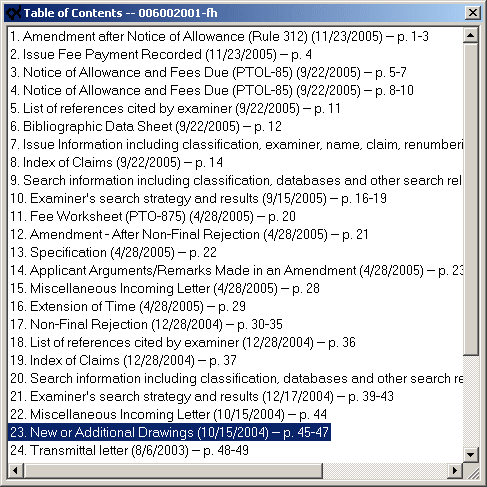 The name of the current section is always displayed in the center
of the Contents Bar.
The name of the current section is always displayed in the center
of the Contents Bar.

8.2. Next and Previous Section
 The Contents Bar provides buttons to move to the next and previous
sections in the document.
The Contents Bar provides buttons to move to the next and previous
sections in the document.
8.3. Page Range
 The page range of the current section is always displayed
on the right side of the Contents Bar.
The page range of the current section is always displayed
on the right side of the Contents Bar.
 .
.
 .
.
9. Interacting with the Windows Clipboard
To copy the current view of the image to the Windows clipboard, select the
Copy to Clipboard command from the View sub-menu of
the right mouse menu.
The image is copied to the clipboard exactly
as it appears on the screen. If the image is scaled such that only a portion of the
image is visible in the window, only that portion of the image is copied to the clipboard.
10. Keyboard Shortcuts
Keyboard shortcuts allow you to initiate
viewer commands directly from the keyboard. Shortcuts are accessible
whenever the viewer window has keyboard focus. The following shortcuts are available:
Key
Description
p
Print the document
s
Save the document
Z
Zoom in (increase the display magnification).
z
Zoom out (decrease the display magnification).
g
Goto page.
Space
Display the next page
Backspace
Display the previous page
c
Copy the current view of the document to the Windows clipboard
b
Go back to the previously viewed page
f
Go forward to the next viewed page
Page Up
Scroll up one screen
Page Down
Scroll down one screen
Home
Scroll to the top of the page
End
Scroll to the bottom of the page
Left Arrow
If the left edge of the image is not visible, scroll left one screen. Otherwise, move to the previous page.
Right Arrow
If the right edge of the image is not visible, scroll right one screen. Otherwise, move to the next page.
Up Arrow
If the top edge of the image is not visible, scroll up one screen. Otherwise, move to the previous page.
Down Arrow
If the bottom edge of the image is not visible, scroll down one screen. Otherwise, move to the next page.
11. Preferences
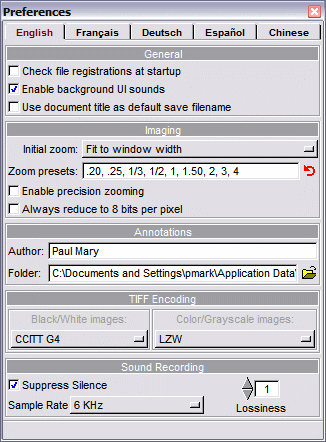 Select the
"View/Preferences" item from the right
mouse menu to edit the CPC View preference settings.
Select the
"View/Preferences" item from the right
mouse menu to edit the CPC View preference settings.
11.1. User Interface Language
 Use the language tabs at the top of the window to specify the user interface language. Click on the appropriate
tab to select the language. The change to the user interface takes effect immediately.
Use the language tabs at the top of the window to specify the user interface language. Click on the appropriate
tab to select the language. The change to the user interface takes effect immediately.
11.2. General

11.3. Imaging

 .
(The zoom pop-up menu appears when you click on the zoom value in the toolbar's zoom control.)
.
(The zoom pop-up menu appears when you click on the zoom value in the toolbar's zoom control.)
11.4. Annotations

 .
.
11.5. TIFF Encoding
 The TIFF file format allows for a variety of different image compression methods. This
section allows you to specify the compression method to use when
CPC View encodes TIFF images.
The TIFF file format allows for a variety of different image compression methods. This
section allows you to specify the compression method to use when
CPC View encodes TIFF images.
If the image is predominantly random noise,
it is possible that turning off compression will result in slightly smaller TIFF files.
If the image is predominantly random noise,
it is possible that turning off compression will result in slightly smaller TIFF files.
11.6. Sound Recording
 This section controls the quality and size of annotation voice recordings.
This section controls the quality and size of annotation voice recordings.
12. Customization
CPC View supports certain customizable features through the Windows
registry. These features are not directly accessible from the CPC View user interface.
They are intended for use within third-party installation programs.
12.1. Specifying the Help URL
[This customization is supported in version 5.3.1 and later.]
HKEY_LOCAL_MACHINE\SOFTWARE\Cartesian Products\CPC View\URLs
Set the value of Help to the desired URL target for the Help... command.
12.1.1. Additional help parameters
If the specified target URL contains a "?", CPC View will append two parameters
to the URL when accessing the help page:
Under version 5.3.1 (or later) of the plug-in, CPC View would access this help
page using the URL
"http://localmirror.com/Help/help.cgi?which=cpcview&version=5.3.1&architecture=plugin"
REGEDIT4
[HKEY_LOCAL_MACHINE\SOFTWARE\Cartesian Products\CPC View\URLs]
"Help"="http://localmirror.com/Help/help.cgi?which=cpcview"
© 1998-2019 Cartesian Products, Inc.
Contact Cartesian